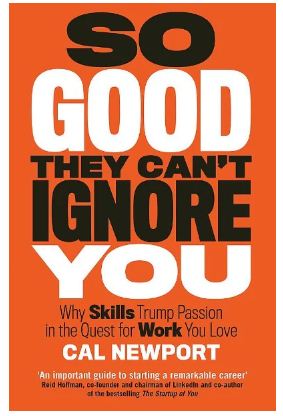
‘So Good, They Can’t Ignore You” by Cal Newport, has quite a few merits.
But as mentioned in this lovely review on goodreads, it harps a bit too much on the ‘passion that kills’ and the book would have been a worthy read without this aspect.
Here are a few interesting points that are a must for everyone to ponder and work on.
- Craftsman mindset: To focus on work and keep getting better at it. In short, being so good, others can’t ignore you. This also reminds us about the famous quote from Bhagavad Githa, where we are urged to focus on work at hand and not worry about the result.
- The movie Groundhog Day offers an amazing example where in the life of Phil (Bill Murray), the weatherman, changes forever when he adopts a craftsman mindset instead of dwelling on what he would like to do.
- In the movie The Shawshank Redemption, Andy (Tim Robbins) resorts to the same craftsman mindset and the results are the best prison library, wonderful chess set and most important all, a way to escape the drudgery of prison life.
- Career capital starts accumulating when the craftsman mindset is in action and it is of immense value. Two types exist–that of winner takes it all, and the other, auction. Once you understand and choose the type, the more the career capital, the merrier.
- In the TV series Madmen, the protagonist Donald Draper (Jon Hamm), keeps on improving his craft in the ‘winner takes it all’ capital market and delivers one win after the other, making his dubious past irrelevant in the overall scheme of things.
- When relegated to mailroom, Clark Morelle (Jack Quaid) in the Martin Scorsese TV series Vinyl, briefly forgets that the career capital market is ‘winner takes it all’, and attempts to do multiple things (as in auction career capital market)to climb back up the ladder. Luckily for him, when he stumbles onto an old album, he realises that good music is all that matters and finds his footing back. This is a bit similar to the TV writer example, Carl Newport, showcases in the book, where once aspirant realises that good writing is all that matters to get ahead in his career.
- Experiencing a sense of control in one’s career and avoiding the career traps—one, that of getting into something way too early that doesn’t work out and two, that of an employer attempting to obstruct the new path by giving a promotion or a raise or meting out more freedom.
- Trap 2 is wonderfully depicted in Manirathnam’s Guru when a young Gurukanth refuses a promotion from his boss, when he thinks he has enough career capital to launch his own business.
- Trap 1 finds an interesting depiction in the movie The Fighter when Micky (Mark Wahlberg) picks another coach instead of his brother Dicky (Christian Bale), and soon finds his beginner’s luck running out. He teams up with him Dicky again, who understands what works for him and with his help, fights his way back to the top.
- Having a mission in one’s life and testing it in small bets.
- In Groundhog’s day, Phil’s routine and mundane existence is transformed the moment he finds his mission in life–to help people no matter what. Interestingly, his mission is always tested in small bets as he keeps reliving the same day, that of Groundhog Day and has to start all over again.
- In Space Cowboys, four old men discover that it is never too late to discover their lost mission and have a wonderful day out in the outer-space.
Overall, the book a good read for anyone who is interested in perspectives to improve their work, career and life.
Related Links
Steve Martin’s interview where he actually said ‘Be so good…”


